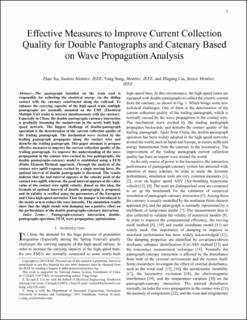| dc.contributor.author | Xu, Zhao | |
| dc.contributor.author | Song, Yang | |
| dc.contributor.author | Liu, Zhigang | |
| dc.date.accessioned | 2021-04-14T11:03:36Z | |
| dc.date.available | 2021-04-14T11:03:36Z | |
| dc.date.created | 2020-08-05T17:31:06Z | |
| dc.date.issued | 2020 | |
| dc.identifier.citation | IEEE Transactions on Vehicular Technology. 2020, 69 (6), 6299-6309. | en_US |
| dc.identifier.issn | 0018-9545 | |
| dc.identifier.uri | https://hdl.handle.net/11250/2737717 | |
| dc.description.abstract | The pantograph installed on the train roof is responsible for collecting the electrical energy via the sliding contact with the catenary constructed along the railroad. To enhance the carrying capacity of the high-speed train, multiple pantographs are normally mounted on the EMU (Electrical Multiple Unit train) to interact simultaneously with the catenary. Especially in China, the double pantographs-catenary interaction is gradually becoming the mainstream in the newly built high-speed network. The biggest challenge of double-pantograph operation is the deterioration of the current collection quality of the trailing pantograph. The mechanical wave excited by the leading pantograph propagates along the contact wire and disturbs the trailing pantograph. This paper attempts to propose effective measures to improve the current collection quality of the trailing pantograph. To improve the understanding of the wave propagation in the contact wire excited by two pantographs, the double pantographs-catenary model is established using a FEM (Finite Element Method) approach. Through the analysis of the contact wire uplift response excited by a single moving force, the optimal interval of double pantographs is discussed. The results indicate that the bad interval appears at the velocity peak of the contact wire uplift, whereas, the good interval appears at the valley value of the contact wire uplift velocity. Based on this idea, the formula of optimal interval of double pantographs is proposed, and its validity is verified using the parameters of the European and China high-speed networks. Then the damper is introduced to the steady arm to reduce the wave intensity. The simulation results show that the slight steady arm damping has a positive effect on the performance of the double pantographs-catenary interaction. | en_US |
| dc.language.iso | eng | en_US |
| dc.publisher | Institute of Electrical and Electronics Engineers (IEEE) | en_US |
| dc.title | Effective Measures to Improve Current Collection Quality for Double Pantographs and Catenary Based on Wave Propagation Analysis | en_US |
| dc.type | Peer reviewed | en_US |
| dc.type | Journal article | en_US |
| dc.description.version | acceptedVersion | en_US |
| dc.source.pagenumber | 6299-6309 | en_US |
| dc.source.volume | 69 | en_US |
| dc.source.journal | IEEE Transactions on Vehicular Technology | en_US |
| dc.source.issue | 6 | en_US |
| dc.identifier.doi | 10.1109/TVT.2020.2985382 | |
| dc.identifier.cristin | 1821913 | |
| dc.description.localcode | © 2020 IEEE. Personal use of this material is permitted. Permission from IEEE must be obtained for all other uses, in any current or future media, including reprinting/republishing this material for advertising or promotional purposes, creating new collective works, for resale or redistribution to servers or lists, or reuse of any copyrighted component of this work in other works. | en_US |
| cristin.ispublished | true | |
| cristin.fulltext | original | |
| cristin.qualitycode | 2 | |
